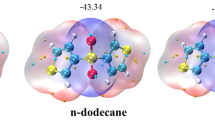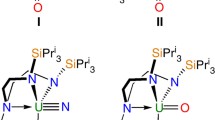Abstract
In this report the affinity of four N4-tetradentate ligands that incorporate the 2-methylpyridyl functionality with hexavalent actinides \((\mathrm{AnO}_{2}^{2+})\) has been investigated in methanol solution. The ligands studied include N,N′-bis(2-methylpyridyl)diaminoethane (BPMDAE), N,N′-bis(2-methylpyridyl)-1,3-diaminopropane (BPMDAP), N,N′-bis(2-pyridylmethyl)piperazine (BPMPIP), and trans-N,N-bis(2-pyridylmethyl)-1,2-diaminocyclohexane (BPMDAC). Conditional stability constants describing the strength of the interaction were determined by UV–visible spectrophotometry. The log10 K 101 values for both U(VI) and Pu(VI) are comparable and show the same trend of stability with ligand structure. Dinuclear complexes are also indicated as being important. The log10 K 201 values for Pu(VI) complexation with the N4-ligands are identical for the four ligands (within experimental error), indicating that the structure of the ligand backbone has little effect on the stability of the (PuO2)2L2+ complex. The exception to this trend is the behavior of N,N′-bis(2-pyridylmethyl)piperazine (BPMPIP) with Pu(VI). This ligand displays a tendency to reduce Pu(VI) within the experimental time frame of 45 minutes. BPMPIP is the only ligand tested that contains tertiary amines in the ligand backbone. The decomposition of BPMPIP by Pu(VI) suggests a susceptibility of tertiary amines to oxidative degradation.







Similar content being viewed by others
References
Nash, K.L.: Separation chemistry for lanthanides and trivalent actinides. In: Gschneider, K.A. Jr., Eyring, L., Choppin, G.R., Lander, G.H. (eds.) Handbook on the Physics and Chemistry of Rare Earths, Lanthanides/Actinides Chemistry, vol. 18, pp. 197–238. Elsevier, Amsterdam (1994)
Kaltsoyannis, N., Scott, P.: In: The F-Elements, pp. 1–84. Oxford University Press, Oxford (1999)
Hay, B.P., Hancock, R.D.: The role of donor group orientation as a factor in metal ion recognition by ligands. Coord. Chem. Rev. 212, 61–78 (2001)
Sinkov, S.I., Rapko, B.M., Lumetta, G.J., Hay, B.P.: Bicyclic and acyclic diamides: comparisons of their aqueous phase binding constants with Nd(III), Am(III), Pu(IV), Np(V), Pu(VI), and U(VI). Inorg. Chem. 43, 8404–8413 (2004)
Lumetta, G.J., Rapko, B.M., Hay, B.P., Garza, P.A., Hutchison, J.E., Gilbertson, R.D.: A novel bicyclic diamide with high binding affinity for trivalent f-block elements. Solvent Extr. Ion Exch. 21, 29–39 (2003)
Ogden, M.D.: The effect of structural hindrance on the complexation of actinides and lanthanides by ligands containing soft nitrogen donors. Ph.D. dissertation, Washington State University (August 2009)
Nash, K.L., Madic, C., Mathur, J.N., Lacquement, J.: In: Morss, L.R., Edelstein, N.M., Fuger, J. (eds.) The Chemistry of the Actinides and Transactinide Elements, vol. 4, 3rd edn., pp. 2622–2798. Springer, Dordrecht (2006)
Newkome, G.R., Frere, Y.A., Fronczek, F.R., Gupta, V.K.: Chemistry of heterocyclic compounds. 104. “Obstacle effect” in palladium(II) complexes of tetraamine ligands with terminal pyridyl or picolyl residues. Inorg. Chem. 24, 1001–1006 (1985)
Schoumacker, S., Hamelin, O., Pécaut, J., Fontecave, M.: Catalytic asymmetric sulfoxidation by chiral manganese complexes: acetylacetonate anions as chirality switches. Inorg. Chem. 42, 8110–8116 (2003)
Halfen, J.A., Uhan, J.M., Fox, D.C., Mehn, M.P., Que, L. Jr.: Copper(II) complexes of pyridyl-appended diazacycloalkanes: synthesis, characterization, and application to catalytic olefin aziridination. Inorg. Chem. 39, 4913–4920 (2000)
Leggett, D.J.: SQUAD: stability quotients from absorbance data. In: Leggett, D.J. (ed.) Computational Methods for the Determination of Formation Constants. Plenum, New York (1985). Chap. 6
Rabinowitch, E., Belford, R.L.: Spectroscopy and Photochemistry of Uranyl Compounds, pp. 1–183. Pergamon, New York (1964)
Martell, A.E., Smith, R.S., Motekaitis, R.J.: NIST critically selected stability constants of metal complexes. NIST Standard Reference Database 46, Version 8.0, Maryland (2004)
Kihara, S., Yoshida, Z., Aoyagi, H., Maeda, K., Shirai, O., Kitatsuji, Y., Yoshida, Y.: A critical evaluation of the redox properties of uranium, neptunium and plutonium ions in acidic aqueous solutions. Pure Appl. Chem. 71, 1771–1807 (1999)
AlMahamid, I., Bercraft, K.A., Hakem, N.L., Gatti, R.C., Nitsche, H.: Stability of various plutonium valence states in the presence of NTA and EDTA. Radiochim. Acta 74, 129–134 (1996)
Reilly, S.D., Neu, M.P.: Pu(VI) hydrolysis: further evidence for a dimeric plutonyl hydroxide and contrasts with U(VI) chemistry. Inorg. Chem. 45, 1839–1846 (2006)
Choppin, G.R., Thakur, P., Mathur, J.N.: Complexation thermodynamics and structural aspects of actinide–aminopolycarboxylates. Coord. Chem. Rev. 250, 936–947 (2006)
Choppin, G.R.: Aspects of plutonium solution chemistry. In: Carnall, W.T., Choppin, G.R. (eds.) Plutonium Chemistry. ACS Symposium Series, vol. 216, pp. 213–230. American Chemical Society, Washington (1983). Chap. 14
Newton, T.W.: Redox reaction of plutonium ions in aqueous solutions. In: Hoffman, D.C. (ed.) Advances in Plutonium Chemistry. American Nuclear Society, La Grange Park (2002). Chap. 3
Van Horn, J.D., Huang, H.: Uranium(VI) bio-coordination chemistry from biochemical, solution and protein structural data. Coord. Chem. Rev. 250, 765–775 (2006)
Acknowledgements
This research was conducted at WSU and PNNL with funding provided by the U.S. Department of Energy, Office of Nuclear Energy, Nuclear Energy Research Initiative Consortium (NERI-C) program under project number DE-FG07-07ID14896.
Author information
Authors and Affiliations
Corresponding authors
Rights and permissions
About this article
Cite this article
Ogden, M.D., Sinkov, S.I., Lumetta, G.J. et al. Affinity of An(VI) for N4-Tetradentate Donor Ligands: Complexation of the Actinyl(VI) Ions with N4-Tetradentate Ligands. J Solution Chem 41, 616–629 (2012). https://doi.org/10.1007/s10953-012-9827-2
Received:
Accepted:
Published:
Issue Date:
DOI: https://doi.org/10.1007/s10953-012-9827-2




